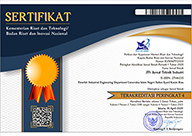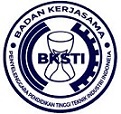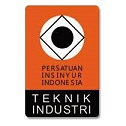Application of Machine Learning for Early Detection of Defective Batik Products Using the Logistic Regression Algorithm
Abstract
The MSME-scale batik industry in Sidoarjo plays a vital role in the regional economy, but product quality consistency remains a challenge due to variations in production processes and the minimal application of data-driven quality control. This research develops a batik product defect prediction model using the Logistic Regression algorithm as an accurate and easily interpretable Machine Learning approach. The dataset consists of 1,250 observations collected over three months of production, covering variables such as dyeing temperature, wax temperature, dye concentration, dipping duration, room humidity, drying duration, operator experience, stamping pressure, and number of products per shift. The results indicate that the Logistic Regression model performs very well, achieving an accuracy of 86.4% and an AUC of 0.91. The variables that most significantly influence defects are room humidity, dyeing temperature, operator experience, and stamping pressure. These findings form the basis for developing a data-driven quality control system that can help MSMEs establish optimal process parameters, manage production capacity, and improve operator skills. This research proves that the Machine Learning approach can be effectively applied in the MSME context with significant practical and operational benefits.
Keywords: Machine Learning, Logistic Regression, Batik MSMEs, Prediction Model
Full Text:
PDFReferences
I. O. Sopacua and N. Primandaru, “Implementasi Quadruple Helix Dalam Mendorong Pertumbuhan Ekonomi Kreatif,” WAHANA J. Ekon. Manaj. dan Akunt., vol. 23, no. 2, 2020, doi: https://doi.org/10.35591/wahana.v23i2.238.
H. Y. Warsono, “Strategi Pemasaran Batik Lamongan dan Kontribusinya terhadap Perekonomian Lokal,” J. Sci. Mandalika, vol. 6, no. 2, pp. 395–402, 2025, doi: https://doi.org/10.36312/10.36312/vol6iss2pp395-402.
I. Mawardi and U. Amanulloh, “Batik sebagai Warisan Budaya serta Meningkatkan Ekonomi Masyarakat,” J. QIEMA (Qomaruddin Islam. Econ. Mag. ), vol. 10, no. 1, pp. 13–25, 2024, doi: https://doi.org/10.36835/qiema.v10i1.4237.
E. D. Kurniati and S. Rahayu, “Design and Technical Quality on The Smes Efficiency : Empirical Evidence from Batik SMEs in Central Java , Indonesia,” J. Ekon. Pembang. Kaji. Masal. Ekon. dan Pembang., vol. 22, no. 1, pp. 22–33, 2021, doi: 10.23917/jep.v22i1.12061.
N. Fajriyah, I. Prasetya, and H. Setiawan, “Quality Control Practices and Sustainability in Batik MSME: A Quantitative Analysis,” Bus. Sustain., vol. 7, no. 4, pp. 314–330, 2023.
A. Sutanto, N. T. Putri, T. Alqifti, and S. M. Yusof, “A Solution Approach on Reducing Defects in Batik Tanah Liek Production Process of a Small and Medium-sized Enterprise,” J. Optimasi Sist. Ind., vol. 23, no. 2, pp. 266–282, 2025, doi: 10.25077/josi.v23.n2.p266-28.
R. Lestari and P. Widodo, “Process Variability and Defect Types in Traditional Batik Production,” Text. Eng. Res., vol. 15, no. 2, pp. 99–112, 2023.
E. D. Astawinetu, Y. K. Wijayanti, and C. Hidayati, “Inovasi Desain Untuk Meningkatkan Kualitas Produk Batik,” J. Plakat, vol. 3, no. 2, pp. 182–193, 2021.
N. T. Hardiyanti and F. Rahmawati, “Peran Modal Sosial Dalam Pengembangan Usaha Sentra Kampoeng Batik Jetis Sidoarjo,” Ganaya J. Ilmu Sos. dan Hum., vol. 5, no. 2, pp. 117–128, 2022, doi: https://doi.org/10.37329/ganaya.v5i2.1710.
F. R. Nafisah, E. Yunaidi, and S. Wahyudi, “The Effect of Responsiveness and Perceived Service Quality on Customer Satisfaction in MSMEs Batik in Semarang City,” Res. Horiz., vol. 4, no. 6, pp. 9–16, 2024, doi: https://doi.org/10.54518/rh.4.6.2024.386.
K. Dermayanti, Sukamto, and M. Dayat, “Leveraging Total Quality Management to Enhance Competitiveness of Batik MSMEs in Gunting Pasuruan,” JoIE J. Islam. Econ. P-ISSN, vol. 4, no. 1, pp. 52–63, 2024, doi: 10.21154/joie.v2i2.3968.
I. Arraniri, D. P. Anjar, and Wulan, “Meningkatkan Kinerja UKM Batik pada Pengusaha Muslimah,” J. Ilm. Ekon. Islam, vol. 7, no. 02, pp. 1151–1155, 2021, doi: https://doi.org/10.29040/jiei.v7i2.2743.
A. R. Harahap et al., “Peran AI dalam UMKM : Bagaimana Kecerdasan Buatan Membantu UMKM Bertahan dan Berkembang di Era Digital,” IKRAITH-EKONOMIKA, vol. 8, no. 1, pp. 409–419, 2025.
A. Wijaya, R. Putri, and D. Hadi, “Digitalization and Predictive Maintenance in Batik Micro-Production,” Digit Transform MSME, vol. 1, no. 3, pp. 140–155, 2023.
muhammad malik Muttofar, E. Retnoningsih, yudi limbar Yasik, and Eliza, Decoding Intelligence Algoritma Machine Learning dalam Aksi dan Bisnis. ALUNGCIPTA, 2025.
H. Syukron and G. T. Solovida, “Sustainable Supply Chain Management Practices in Batik Small and Medium Scale Enterprises Performance,” J. Penelit. Ekon. dan Bisnis Sustain., vol. 7, no. 2, pp. 71–80, 2022, doi: https://doi.org/10.33633/jpeb.v7i2.4714.
A. Sudaryanto, F. Wibisono, and R. Sari, “Applying Predictive Models in Traditional Craft MSMEs: A Case Study of Batik Production,” Small Bus Tech, vol. 5, no. 2, pp. 95–110, 2023.
D. Hosmer, S. Lemeshow, and R. Sturdivant, Applied Logistic Regression. Wiley, 2013.
G. James, D. Witten, T. Hastie, and R. Tibshirani, An Introduction to Statistical Learning. Springer US, 2021.
J. W. Creswell, Research Design: Qualitative, Quantitative, and Mixed Methods Approaches. SAGE, 2014.
Sugiyono, Metode Penelitian Kuantitatif, Kualitatif, dan R&D. Alfabeta, 2019.
A. Agresti, Statistical Methods for the Social Sciences. Pearson, 2018.
S. Menard, Logistic Regression: From Introductory to Advanced Concepts and Applications. SAGE, 2010.
J. Han, M. Kamber, and J. Pei, Data Mining: Concepts and Techniques. Morgan Kaufmann, 2022.
A. Géron, Hands-On Machine Learning with Scikit-Learn, Keras, and TensorFlow. O’Reilly, 2022.
M. Kuhn and K. Johnson, Applied Predictive Modeling. Springer US, 2013.
O. A. Nareswari, N. U. Handayani, and Sriyanto, “Analisis Regresi Logistik Faktor yang Mempengaruhi Keputusan Pembelian Smartphone Merek Samsung,” J@ti Undip J. Tek. Ind., vol. 18, no. 3, pp. 182–189, 2023, doi: https://doi.org/10.14710/jati.18.3.182-189.
DOI: http://dx.doi.org/10.24014/jti.v11i2.38543
Refbacks
- There are currently no refbacks.
Copyright (c) 2025 Untung Usada

This work is licensed under a Creative Commons Attribution-NonCommercial-ShareAlike 4.0 International License.
Jurnal Teknik Industri
P-ISSN 2460-898X | E-ISSN 2714-6235
Published by:
Industrial Engineering Department
Universitas Islam Negeri Sultan Syarif Kasim Riau, Indonesia
Office Address:
H.R. Soebrantas KM 15.5, Tampan, Pekanbaru, Riau, Indonesia 28293
email: jti.fst@uin-suska.ac.id
Indexed by:
JTI : Jurnal Teknik Industri under a Creative Commons Attribution-NonCommercial-ShareAlike 4.0 International License.

















